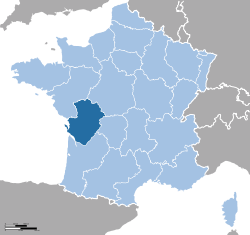Poitou-Charentes
| Poitou-Charentes | |||
|---|---|---|---|
| — Region of France — | |||
|
|||
 |
|||
| Country | France | ||
| Prefecture | Poitiers | ||
| Departments | |||
| Government | |||
| - President | Ségolène Royal (PS) | ||
| Area | |||
| - Total | 25,809 km2 (9,964.9 sq mi) | ||
| Population (2007-01-01) | |||
| - Total | 1,722,000 | ||
| - Density | 66.7/km2 (172.8/sq mi) | ||
| Time zone | CET (UTC+1) | ||
| - Summer (DST) | CEST (UTC+2) | ||
| NUTS Region | FR5 | ||
| Website | poitou-charentes.fr | ||
Poitou-Charentes (French pronunciation: [pwatu ʃaʁɑ̃t] (![]() listen)) is an administrative region in central western France comprising four departments: Charente, Charente-Maritime, Deux-Sèvres and Vienne. The regional capital is Poitiers.
listen)) is an administrative region in central western France comprising four departments: Charente, Charente-Maritime, Deux-Sèvres and Vienne. The regional capital is Poitiers.
Contents |
Politics
The regional council is composed of 56 members. The region is the home of France's losing presidential candidate Socialist Ségolène Royal in the election of 2007.
Demographics
In French its residents are known as Picto-Charentais. In 2003, the region ranked 15th out of 26 in population. In area it ranked 12th in size.
Three regional languages, Poitevin, Saintongeais and Limousin are spoken by a minority of people in the region.
Poitou is believed to be the region of origin of most of the Acadian and Cajun populations of North America (now found chiefly in New Brunswick and Louisiana, respectively).[1] Their ancestors emigrated from the region in the 17th and 18th centuries.
At first, these French immigrants from Poitou settled in eastern Canada, and established an agricultural and maritime economy (farming and fishing). This area of the "New World" was dubbed Acadia by the French, after the Greek Arcadia - the idyllic part of the Peloponnesian peninsula in Greece. It was renamed Nova Scotia (New Scotland) in the aftermath of the 1755 expulsion of most of the Acadians by the English.
History
Poitou is a historic region in west central France. Poitiers, the former capital of the region, is its chief city, although the port of La Rochelle rivals it in economic importance. Farming is important to the economy; wheat, corn and cattle are raised. Industries produce machinery, chemicals and dairy products.
The region's first known inhabitants, the Pictavi, a Gallic tribe, were conquered in 56 BC by the Romans who incorporated the area into Gaul as part of the province of Aquitania. The Visigoths seized the region in 418 AD, but it passed to the Franks in 507. In 732 or 733, Charles Martel brought the Muslim invasion of Western Europe to a standstill by his victory in the Battle of Poitiers. From the 10th to the mid-12th century, the counts of Poitou were also the dukes of Aquitaine, and the city of Poitiers grew in importance.
In 1152, Poitou came under English control through the marriage of Eleanor of Aquitaine to Henry II (later king of England). The region was reunited with the French crown in 1416 and was a province of France until the Revolution (1789–95), when it was divided into three departments, Vienne, Deux-Sèvres, and Vendee.
Françoise-Athénaïs, marquise de Montespan was born in the area in 1640 (d 1707). She was the famous mistress to Louis XIV; Some of their descendants are still alive today.
Major communities
References
- ↑ source: Dr. Carl Brasseaux, director of the Center for Louisiana Studies at The University of Louisiana in Lafayette, LA
External links
- (French) Regional Council Website
- Official Regional Tourist Board website
- Short tourist guide to Poitou-Charentes
- (French) Site de l'Observatoire Régional de l'Environnement de Poitou-Charentes
- (French) Site sur la biodiversité en Poitou-Charentes
- (French) Youth portal for Poitou-Charentes
|
||||||||

.png)